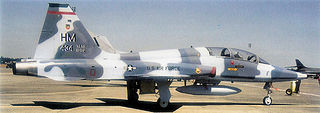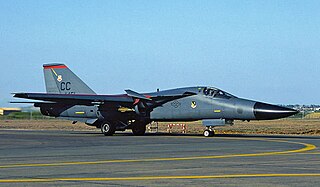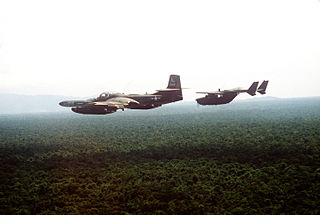
Luke Air Force Base is a United States Air Force base in Maricopa County, Arizona, United States. It is located 7 miles west of the central business district of Glendale, and 15 miles west of Phoenix.

The 561st Weapons Squadron is a United States Air Force squadron assigned to the USAF Weapons School at Nellis Air Force Base, Nevada. The squadron was the last United States Air Force unit to fly the McDonnell F-4 Phantom II on operational missions. The last Republic F-105 Thunderchief shot down in the Vietnam War was from the 561st.

George Air Force Base was a United States Air Force base located within the city limits, 8 miles northwest, of central Victorville, California, about 75 miles northeast of Los Angeles, California.

The 57th Wing is an operational unit of the United States Air Force (USAF) Warfare Center, stationed at Nellis Air Force Base, Nevada.

The 479th Tactical Training Wing is an inactive United States Air Force unit. Its last assignment was with Tactical Training, Holloman, stationed at Holloman Air Force Base, New Mexico. It was inactivated on 26 July 1991.

The 479th Flying Training Group is a United States Air Force unit, stationed at Naval Air Station Pensacola. A component of Air Education and Training Command, the group was activated on 2 October 2009. The current commander of the 479th Flying Training Group is Col Patrick "PDiddy" Dierig.

The 21st Fighter Squadron is part of the 56th Operations Group at Luke Air Force Base, Arizona, however it is separately based at Morris Air National Guard Base. It is a United States Air Force squadron that operates Taiwan-owned General Dynamics F-16V Fighting Falcon aircraft conducting fighter and maintenance training for the pilots and maintainers of the Republic of China Air Force.

The 418th Test and Evaluation Squadron is an active United States Air Force unit assigned to the 53rd Test and Evaluation Group, and stationed at Davis-Monthan Air Force Base, Arizona, where it was activated on 1 October 2021.

The 832nd Air Division is an inactive United States Air Force organization. Its last assignment was with Tactical Air Command, (TAC) assigned to Twelfth Air Force at Luke Air Force Base, Arizona, where it was inactivated on 1 October 1991.

Air Forces Panama is an inactive United States Air Force (USAF) headquarters. It was assigned to Tactical Air Command, most recently to Twelfth Air Force. Its headquarters were located at Albrook Air Force Station and Howard Air Force Base in the Panama Canal Zone. The organization was inactivated on 11 February 1992.

The 833d Air Division is an inactive United States Air Force (USAF) organization. Its last assignment was with Tactical Air Command (TAC), assigned to Twelfth Air Force at Holloman Air Force Base, New Mexico. It was inactivated on 15 November 1991.

The 836th Air Division is an inactive United States Air Force organization. Its last assignment was with Tactical Air Command (TAC) at Davis-Monthan Air Force Base, Arizona, where it was inactivated on 1 May 1992. The division had been activated at Davis-Monthan in January 1981 to replace Tactical Training, Davis-Monthan. Its primary mission was training for Fairchild A-10 Thunderbolt II and BGM-109G Gryphon crews. The 602d Tactical Control Wing moved to Davis-Monthan, and the division's training mission expanded to include Forward Air Controllers flying several aircraft. The BGM-109 mission ended with the signing of the Intermediate-Range Nuclear Forces Treaty. In 1989, division elements participated in Operation Just Cause. The division was inactivated with the implementation of the Objective Wing reorganization, which established a single wing on each Air Force Base.

The 835th Air Division is an inactive United States Air Force (USAF) organization. Its last assignment was to Twelfth Air Force of Tactical Air Command (TAC) at McConnell Air Force Base, Kansas, where it was inactivated on 30 June 1971.

The 434th Flying Training Squadron is part of the 47th Flying Training Wing based at Laughlin Air Force Base, Texas. It operates Beechcraft T-6 Texan II aircraft conducting flight training.

The 435th Fighter Training Squadron is part of the 12th Flying Training Wing based at Randolph Air Force Base, Texas. It operates Northrop AT-38 Talon aircraft conducting flight training.

The 563rd Flying Training Squadron is an inactive United States Air Force unit. It was part of the 12th Flying Training Wing at Randolph Air Force Base, Texas, where it operated the Boeing T-43 Bobcat conducting navigator training until inactivating on 19 November 2010.

The 433rd Weapons Squadron is a United States Air Force unit, assigned to the USAF Weapons School at Nellis AFB, Nevada.

The 306th Fighter Squadron is an active United States Air Force unit. It was most recently activated as an active associate unit of the 119th Fighter Squadron of the New Jersey Air National Guard, stationed at Atlantic City Municipal Airport.

The 476th Tactical Fighter Squadron is an inactive United States Air Force unit. It flew North American F-100 Super Sabre and Lockheed F-104 Starfighter fighters at George Air Force Base, California from October 1957 until 1968, when moved to Seymour Johnson Air Force Base, where was to fly McDonnell F-4 Phantom IIs, but did not become operational before inactivating in March 1969.

The 12th Flying Training Wing is a United States Air Force unit assigned to Air Education and Training Command's Nineteenth Air Force. It is headquartered at Joint Base San Antonio, Texas. The wing is the parent organization for the 479th Flying Training Group, located at NAS Pensacola, Florida and the 306th Flying Training Group, at The United States Air Force Academy, Colorado. The 12th Wing is the only unit in the Air Force conducting both pilot instructor training and combat systems officer training.



























